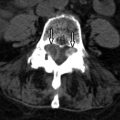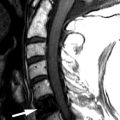Clinical Presentation
The patient is a 58-year-old man with 4- to 6-week history of low back pain, bilateral buttock pain, right lower extremity pain, numbness of both feet, and difficulty walking. He has weakness in both hip extensors, both hip abductors, and bilateral weakness of the foot, right greater than left. Clinical findings are consistent with multilevel radiculopathy and neurogenic claudication.
Imaging Presentation
Magnetic resonance (MR) imaging of the lumbar spine reveals a large, lobulated synovial cyst arising from the anteromedial aspect of the right L4-5 facet joint. The cyst encroaches upon the medial aspect of the right L4-5 neural foramen and causes marked compression and displacement of the thecal sac from right to left ( Figs. 75-1 to 75-6 ) .






Discussion
Synovial cysts are synovial-lined cystic outpouchings that communicate with the facet joint. Synovial cysts arise within thickened, redundant synovium and facet capsular tissue. Synovial cysts most commonly arise in the setting of facet joint osteoarthritis, as a result of chronic inflammation and facet degeneration, but can arise secondary to acute or repeated trauma, rheumatoid arthritis, or calcium pyrophosphate deposition disease (CPPD).
Most synovial cysts arise in the lower lumbar region, likely secondary to mechanical stress. These cysts contain gelatinous liquid or synovial fluid. Hypermobility of the facet joint (facet subluxation) is considered an important predisposing factor in synovial cyst formation. There is an increased incidence of symptomatic synovial cyst formation in patients with facet joint mobility or spondylolisthesis. In the lumbar region, the greatest mobility is at the L4-5 level, and the majority (80%) of lumbar synovial cysts arise at the L4-5 level, more frequently occurring on the right side, for reasons unknown. Tiny (less than 5 mm diameter) synovial cystic outpouchings from the posterior-inferior facet joint capsule are very common and usually asymptomatic. Synovial cysts that project from the facet joint medially extend into the spinal canal where they may cause significant compression of the lateral aspect of the thecal sac (see Figs. 75-4 to 75-6 ). Most of these cysts are less than 1.5 cm in diameter, but they can be larger. Some medial projecting synovial cysts extend into the potential space between the lamina and ligamentum flavum, displacing the ligamentum flavum medially; these cysts communicate with the facet joint ( Fig. 75-7 ) . These cysts may be confused with nonsynovial-lined flavum cysts that are attached to or embedded within the ligamentum flavum that do not communicate with the facet joint ( Figs. 75-8 and 75-9 ) . Synovial cysts may also project from the anterosuperior margin of the facet joint into the neural foramina ( Figs. 75-10 and 75-11 ) , where they may be confused for nerve sheath cysts that also occur in the neural foramen.














